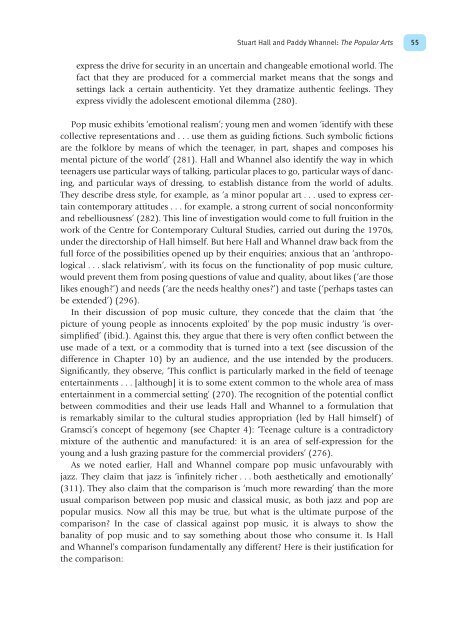Cultural Theory and Popular Culture
Cultural Theory and Popular Culture
Cultural Theory and Popular Culture
Create successful ePaper yourself
Turn your PDF publications into a flip-book with our unique Google optimized e-Paper software.
Stuart Hall <strong>and</strong> Paddy Whannel: The <strong>Popular</strong> Arts 55<br />
express the drive for security in an uncertain <strong>and</strong> changeable emotional world. The<br />
fact that they are produced for a commercial market means that the songs <strong>and</strong><br />
settings lack a certain authenticity. Yet they dramatize authentic feelings. They<br />
express vividly the adolescent emotional dilemma (280).<br />
Pop music exhibits ‘emotional realism’; young men <strong>and</strong> women ‘identify with these<br />
collective representations <strong>and</strong> . . . use them as guiding fictions. Such symbolic fictions<br />
are the folklore by means of which the teenager, in part, shapes <strong>and</strong> composes his<br />
mental picture of the world’ (281). Hall <strong>and</strong> Whannel also identify the way in which<br />
teenagers use particular ways of talking, particular places to go, particular ways of dancing,<br />
<strong>and</strong> particular ways of dressing, to establish distance from the world of adults.<br />
They describe dress style, for example, as ‘a minor popular art . . . used to express certain<br />
contemporary attitudes . . . for example, a strong current of social nonconformity<br />
<strong>and</strong> rebelliousness’ (282). This line of investigation would come to full fruition in the<br />
work of the Centre for Contemporary <strong>Cultural</strong> Studies, carried out during the 1970s,<br />
under the directorship of Hall himself. But here Hall <strong>and</strong> Whannel draw back from the<br />
full force of the possibilities opened up by their enquiries; anxious that an ‘anthropological<br />
. . . slack relativism’, with its focus on the functionality of pop music culture,<br />
would prevent them from posing questions of value <strong>and</strong> quality, about likes (‘are those<br />
likes enough?’) <strong>and</strong> needs (‘are the needs healthy ones?’) <strong>and</strong> taste (‘perhaps tastes can<br />
be extended’) (296).<br />
In their discussion of pop music culture, they concede that the claim that ‘the<br />
picture of young people as innocents exploited’ by the pop music industry ‘is oversimplified’<br />
(ibid.). Against this, they argue that there is very often conflict between the<br />
use made of a text, or a commodity that is turned into a text (see discussion of the<br />
difference in Chapter 10) by an audience, <strong>and</strong> the use intended by the producers.<br />
Significantly, they observe, ‘This conflict is particularly marked in the field of teenage<br />
entertainments . . . [although] it is to some extent common to the whole area of mass<br />
entertainment in a commercial setting’ (270). The recognition of the potential conflict<br />
between commodities <strong>and</strong> their use leads Hall <strong>and</strong> Whannel to a formulation that<br />
is remarkably similar to the cultural studies appropriation (led by Hall himself) of<br />
Gramsci’s concept of hegemony (see Chapter 4): ‘Teenage culture is a contradictory<br />
mixture of the authentic <strong>and</strong> manufactured: it is an area of self-expression for the<br />
young <strong>and</strong> a lush grazing pasture for the commercial providers’ (276).<br />
As we noted earlier, Hall <strong>and</strong> Whannel compare pop music unfavourably with<br />
jazz. They claim that jazz is ‘infinitely richer . . . both aesthetically <strong>and</strong> emotionally’<br />
(311). They also claim that the comparison is ‘much more rewarding’ than the more<br />
usual comparison between pop music <strong>and</strong> classical music, as both jazz <strong>and</strong> pop are<br />
popular musics. Now all this may be true, but what is the ultimate purpose of the<br />
comparison? In the case of classical against pop music, it is always to show the<br />
banality of pop music <strong>and</strong> to say something about those who consume it. Is Hall<br />
<strong>and</strong> Whannel’s comparison fundamentally any different? Here is their justification for<br />
the comparison:
















